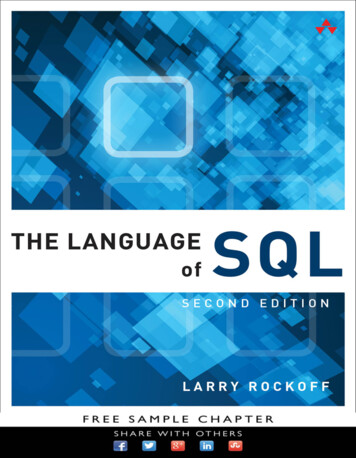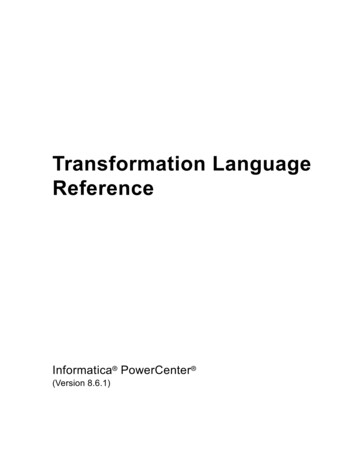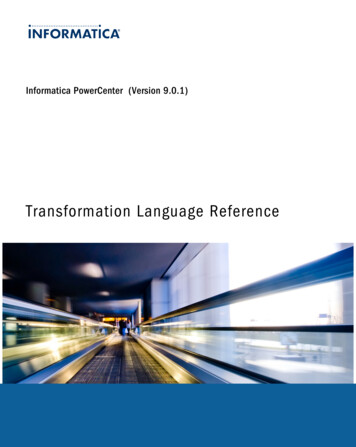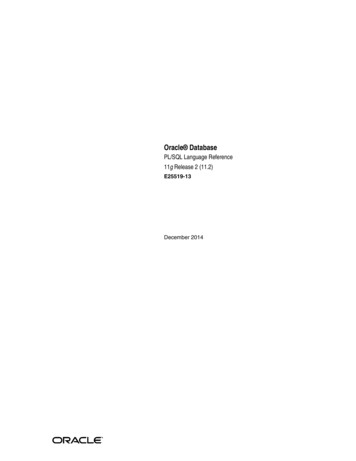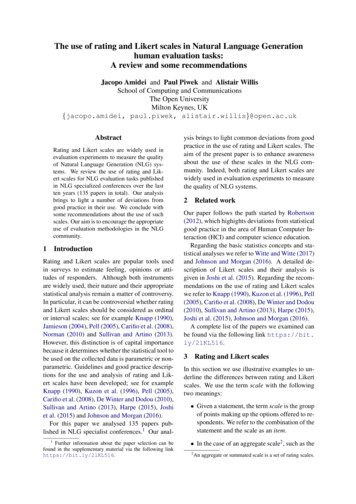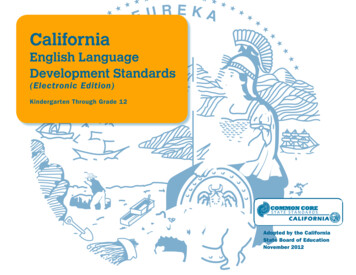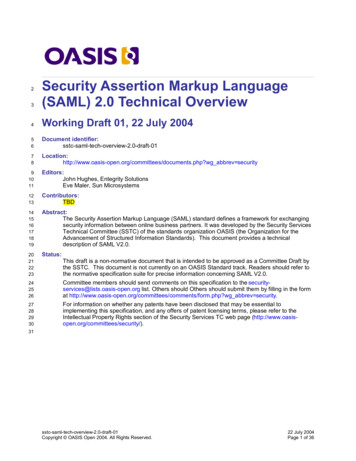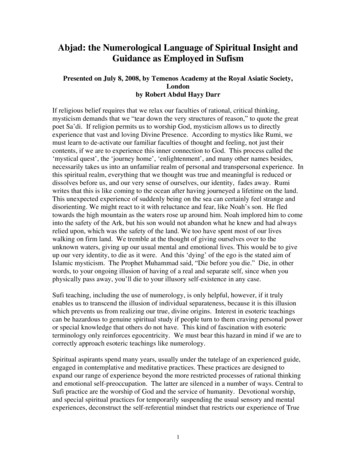
Transcription
Abjad: the Numerological Language of Spiritual Insight andGuidance as Employed in SufismPresented on July 8, 2008, by Temenos Academy at the Royal Asiatic Society,Londonby Robert Abdul Hayy DarrIf religious belief requires that we relax our faculties of rational, critical thinking,mysticism demands that we “tear down the very structures of reason,” to quote the greatpoet Sa’di. If religion permits us to worship God, mysticism allows us to directlyexperience that vast and loving Divine Presence. According to mystics like Rumi, wemust learn to de-activate our familiar faculties of thought and feeling, not just theircontents, if we are to experience this inner connection to God. This process called the‘mystical quest’, the ‘journey home’, ‘enlightenment’, and many other names besides,necessarily takes us into an unfamiliar realm of personal and transpersonal experience. Inthis spiritual realm, everything that we thought was true and meaningful is reduced ordissolves before us, and our very sense of ourselves, our identity, fades away. Rumiwrites that this is like coming to the ocean after having journeyed a lifetime on the land.This unexpected experience of suddenly being on the sea can certainly feel strange anddisorienting. We might react to it with reluctance and fear, like Noah’s son. He fledtowards the high mountain as the waters rose up around him. Noah implored him to comeinto the safety of the Ark, but his son would not abandon what he knew and had alwaysrelied upon, which was the safety of the land. We too have spent most of our liveswalking on firm land. We tremble at the thought of giving ourselves over to theunknown waters, giving up our usual mental and emotional lives. This would be to giveup our very identity, to die as it were. And this ‘dying’ of the ego is the stated aim ofIslamic mysticism. The Prophet Muhammad said, “Die before you die.” Die, in otherwords, to your ongoing illusion of having of a real and separate self, since when youphysically pass away, you’ll die to your illusory self-existence in any case.Sufi teaching, including the use of numerology, is only helpful, however, if it trulyenables us to transcend the illusion of individual separateness, because it is this illusionwhich prevents us from realizing our true, divine origins. Interest in esoteric teachingscan be hazardous to genuine spiritual study if people turn to them craving personal poweror special knowledge that others do not have. This kind of fascination with esotericterminology only reinforces egocentricity. We must bear this hazard in mind if we are tocorrectly approach esoteric teachings like numerology.Spiritual aspirants spend many years, usually under the tutelage of an experienced guide,engaged in contemplative and meditative practices. These practices are designed toexpand our range of experience beyond the more restricted processes of rational thinkingand emotional self-preoccupation. The latter are silenced in a number of ways. Central toSufi practice are the worship of God and the service of humanity. Devotional worship,and special spiritual practices for temporarily suspending the usual sensory and mentalexperiences, deconstruct the self-referential mindset that restricts our experience of True1
Reality. Over time, these approaches lead to a fundamental shift in the psyche. The soulexpands as self-preoccupation diminishes. The soul discovers intimacy with an oceanicspiritual awareness through which it becomes conscious of the symbolic nature of thingsand events. As spiritual aspirants lose the usual bearings of the shore they must, to quoteRumi, find safety in the company of a guide, “the Noah of the time,” and travel in the arkof the Sufi Tradition. The stored provisions for this journey include the Book ofRevelation, and the literature and art produced by generations of mystic seafarers.Symbolism is used by Sufis to evoke an awareness of the Eternal. Sufi poetry andteaching stories are layered with evocative symbols that inform and awaken differentlevels of our being. Beyond the narrative, there are deeper levels of symbolism presentedthrough literary devices such as double-entendre, root-word resonance and numerology.The Islamic world was heir to the alphabetical numerology already used for centuriesthroughout the Near East. In this system, each letter of the alphabet also represents anumber. A system of alphabetical numbering of things was the common practice inArabia prior to the introduction of Indian numerals. We now call them Arabic numerals,but they were not commonly used in Arabia prior to the 9th century. Alphabeticalnumbers were used instead. Arabs were raised reading letters as numbers and would, as amatter of course, see words simultaneously as a collection of numbers. Numbers had tobe colored or overlined to distinguish them from words. Given these facts, it is easy toimagine the development of a sophisticated usage of alphabetical numerology in Arabic.Here is the main Islamic version of this system.Abjad hawaz huttykalimansa’afas1,2,3,4, s might have first applied abjad while trying to understand certain mysteriousletters at the beginning of some of the chapters of the Qur'an, letters whose existence andpurpose has never definitively been explained. As they began to use abjad as a tool tostudy the verses of the Qur’an, they noticed numerological correspondences betweensome of the Divine Names, the various aspects of God. This was sufficient proof, formany, that numerology was inherent in the revelation. For example, lists of the ninetynine Names of Allah, usually begin with ar-Rahman, the Merciful, and end with asSabur, the Patient. These each have the same abjad of 329. Another example is theLoving, al-Wadud, and the Guide, al-Hadi, both have an abjad number of 51. It is notdifficult to grasp the conceptual link between two Divine Names with identicalnumerology but those who intellectually grasped this, rarely considered it to be of anygreat significance. For the mystic, on the other hand, whose intellectual powers haveauspiciously faded in the bright light of internal revelation, these connections resonatemore deeply. The mystic also encounters mystical symbols with the mind. But themystic’s mind has undergone a perceptual shift such that his or her awareness of theunderlying Source of Being outshines the usual thinking processes. The mysticexperiences a profound recognition of the existential reference of any given symbol,2
beyond the mere intellectual understanding of its numerological relationship to the idea itrepresents. Having left the familiar, safe shore of ego-identification, the awe-struckseeker journeys across the spiritual ocean in a state of existential perplexity. Thisperplexity is the natural outcome of exploding the myth of a fixed sense of self. In thevast, unspeakable beauty of this night of perplexity, the mystic apprehends symbolicmeanings of various kinds which illuminate his or her consciousness like moonlight.Spiritual meanings, whether appearing in the guise of visionary images or of sublimeideas, expand the soul’s awareness of its own reflected luminosity.Another example of numerology involves the name of Allah, the name of God that isinclusive of divine transcendence and immanence. Allah has an abjad of 66. Since thename Allah is considered inclusive of all of the 99 Names of God, mystics have foundsignificance in the fact that 66 and 99 add up to the abjad number of the Islamictestimony of the faith, La ilaha illa Allah, which has an abjad number of 165. They foundfurther significance in the fact that 165 is also the number for the Divine Name, asSamad, the Eternal Sustainer. This kind of metaphysical relationship might, for a novicein this study, reveal itself only through a systematic numerological analysis of terms andideas. With more familiarity, the numerology of a word or phrase might be immediatelyevident, and numerological teachings can even occur in dreams and meditative visions.Either way, the mystic soul discovers meanings like the one I’ve just indicated for thenumber 165. In that example of the Eternal Sustainer, 165 becomes the sign or the icon ofan intimate, present God, the One who sustains His creation and communicates lovinglywith it through His Divine Names.Abjad is part of a great alphabetical science called the ‘Science of Letters’, the ‘ilm alhuruf. This science concerns itself not only with the numerological aspect of letters butalso with the study of the shapes of letters and their cosmological significance. The letteralef, for example, is not only shaped like the number one but is the number ‘one’ inabjad. It is the original letter and represents the principle of unitary Being. The otherletters of the alphabet are said to have evolved from the letter alef into the variety andmultiplicity of the alphabet which for the hurufis represents the cosmos. Sufis andMuslim esotericists wrote complex treatises on the Science of Letters, drawing uponletter-symbolism found in the Qur’an to support their various hypotheses. Thesesometimes quite popular theories have for centuries attracted seekers of hidden meaningsthat were believed to exist in the Qur’an. There are even contemporary teachings that stilluse this approach, such as the late Dr. Khalifa’s numerological study of the Qur’an whichrevealed a repeating pattern of 19, the abjad number for the concept of unity in the DivineName, Wahed. The weight of the evidence for the existence of numerology in the Qur’anis sufficient to convince even a skeptic that there is a numerological pattern at work in thescripture. The Sufi is interested in how to make use of such a discovery beyond a merefascination with the mysterious. Sufi poets and writers used numerology to enrich theiralready potent mystical literature. Numerology is not at all a necessary part of Sufiteaching, but it can be found embedded in mystical literature as another layer ofinstruction. It exists to enhance our understanding of the overt spiritual message. Thisenrichment of spiritual literature may allow us to integrate the message more fully, moredeeply than our usual intellectual processing of information.3
As already pointed out, Sufis use symbolism to evoke and revive our forgotten awarenessof the Eternal. In order to better understand how abjad symbolism is employed in Sufiliterature, let us now take an example from the life of Jesus. The story of the annunciationas presented in the Qur’an and expanded in Sufi literature describes the Virgin Marybathing when she is approached by the Angel Gabriel. In the Qur’an, Gabriel is called aspirit [ruh] and a divine messenger [rasul]. He appears to Mary as a ‘well-formed’ man.Mary, in her state of ascetic purity, projects a psychological shadow on the figure ofGabriel by imagining that he wants to lie with her sexually. Gabriel assures her that he isonly there to bring her the good news of a pure boy who will be the messenger of God.One excellent Sufi commentary on the Qur’anic account of Jesus is Ibn ‘Arabi’s chapteron the Wisdom of Jesus in his Fusus al-Hikam, the Bezels of Wisdom. The Shaykh callsthis the Wisdom of Prophecy. Prophets usually bring textual revelations to theircommunities. In this case the prophetic message is Jesus himself who, as Ruhullah, theSpirit of Allah, will directly manifest the spiritual reality of prophecy. Perhaps the besttranslation for the Arabic root word of prophecy, naba, is the English word, to inform, ifwe take both meanings of ‘inform’: to give news and to take on form. Going to thenumerology surrounding the story of Jesus, we find that Gabriel, Jibr’il in Arabic, has anabjad number of 245 which, interestingly enough, is exactly the same as for the word arruh, Spirit. As already noted, Gabriel is called a ‘messenger’ and in this case, his messageis the divine Spirit that he blows into Mary. In the Qur’an Jesus is called Ruhullah, theSpirit of Allah. Mary is also related to the principle of ‘informing’ because her own nameMariam has an abjad number of 290 which is the same as the Arabic root for theinforming message, rasala. Ibn ‘Arabi’s exegesis explains that the reality of prophecy isthe reality of ‘informing,’ of Spirit taking on form. Gabriel is a spirit ‘informer’ whotakes on the form of a ‘well-made’ man on the occasion of blowing the divine Spirit intoMary. This Spirit is the principle of life itself which is why Jesus can bring the dead backto life and why he can blow the spirit into clay birds which then fly away.In the Qur’an, Jibr’il is called the ‘trusty spirit’ ar-Ruh al-amin. Al-Amin, theTrustworthy, is also a name of the Prophet Muhammad. It has an abjad of 132. This isthe abjad number for the word qalb which means heart or spiritual consciousness. This isan important abjad number for the Sufis because it is also the abjad for Muhammad,(bycounting the doubled mim) and for the totality of the essences [‘ayan] of things that canbe witnessed in the purified heart. The purified heart means a heart that is alive throughthe Spirit which is why it can know and inform, that is reveal the theophanies thatmanifest in it. Jesus [‘Isa] has an abjad number of 150 which is the same as the numberfor God’s Name, Knowing [‘Alim]. In the case of Jesus, this refers to a direct spiritualknowing which is only possible for a living heart. By adding the abjad of ‘heart,’ 132,and Spirit’s synonym, the Divine Name, Living, [Hayy], 18, we get the same number,150.So how does the spiritual aspirant learn from the ‘informing’ of the story of Jesus? Afterreading and studying both the Qur’anic account and various presentations of Sufiexegesis on the story, the seeker consciously personalizes the story. Details of theaccount are closely studied, including the numerological references that provide a more4
profound sense of the story’s significance. After becoming ‘informed’ by th
Sufi poets and writers used numerology to enrich their already potent mystical literature. Numerology is not at all a necessary part of Sufi teaching, but it can be found embedded in mystical literature as another layer of instruction. It exists to enhance our understanding of the overt spiritual message. This enrichment of spiritual literature may allow us to integrate the message more fully .File Size: 339KBPage Count: 11

